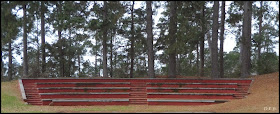The following transcription is from a series of recordings my father made in the early 1990s:
Butchering Cows...
In the 1930s, Mr. Buck Smith had a meat market. He would purchase a yearling or calf from folks out in the country and bring it over to the old stand of cottonwoods out behind our house and butcher it.
When I was a child, I watched him butcher a many a cow. The carcass would be hauled off to his store where it would be cut up into different cuts of meat. I even remember the people he would bring with him to help with the butchering.
Sometimes he would bring Albert Shaw and other times he would bring Little Harry Jenkins. A lot of times he would bring an old black man off the Peck place named Major Brass.
Major Brass rode an ole horse that had the longest legs I ever saw. I’d see him riding past our house; back and forth, going and coming from the Peck place. He lived behind the Gillis house in the Gillis quarters where former slaves lived.
Gillis House
Cattle and hogs ran loose in town back in those days. When Mr. Buck would butcher a cow, other cows would smell the blood and come running from way on the other side of the Village. The cows would bellow and low. They would hook and fight at each other. Late into the evening, long after the butchering was over, you could still hear the cows bellowing over in that stand of trees.
A hog law was passed in the 1940s that forced people to pen their hogs to prevent them from wandering loose in the Village. Up until the town was incorporated in the 1950s, cows continued to roam all over the area.
Cotton Pickers, Carpenters and School Teachers...
There were times when I remember cotton pickers being paid fifty cents a pound for cotton that was hand picked out of the cotton fields. There weren’t any cotton picking machines. It was all picked by hand. An average cotton picker could pick about 200 pounds a day. A pretty good cotton picker might pick 250-270 pounds of cotton a day. There were people who could actually pick 400 pounds or more a day.
The average carpenter probably made close to seventy-five cents an hour. School teachers made something like $75 a month. The principal was paid a little more.
Of course things were cheaper back in the early to mid-1930s. Seventy-five dollars a month would buy a lot of things. You could buy a bottle of ketchup for a dime, a big box of matches for a nickel, and a cold drink for a nickel.
A 25 pound sack of meal went for about 40 cents and a 25 pound sack of flour went for maybe 85 cents.
A pair of overalls cost about 1.50 and a pair of dress shoes went for 4 or 5 dollars. Cigarettes cost about 17 cents a pack and gasoline was around 13 cents a gallon.
Country Doctors and Medicine...
People didn’t have the money to pay doctors. The country doctors who worked out in the rural areas were paid with hens, eggs, cows, and vegetables out of gardens.
I’m remembering the kinds of medicine doctors gave to people back in those days. I don’t remember the ailment, but I do remember being given Calomel. It made me sick at my stomach. Maybe it was given for malaria, I don’t remember.
Children with sore throats had their throats mopped with silver nitrate. I had mine mopped several times. Dr. Gordon would have an ole stick of some kind that looked like a sucker stick. It had a piece of cotton on the end of it and he would put the stick down in some kind of red looking medicine. A spoon was used to hold your mouth open while the doctor mopped your throat.
Vick’s Salve. Vick’s Salve was probably here when the world began! As far back as I can remember we had Vick’s Salve.
Luden’s cough drops were sold in a little orange pasteboard container.
A cough medicine called 666 and Groves Chill Tonic were sold over the counter in most stores.
Carter’s Little Liver Pills and Doan’s Pills for back ache were other medicines you could buy in the stores.
Home Remedies...
Apparently after a long winter, people believed they needed to get their bodies straight and so they took all types of things to clean their bodies up in the spring time.
In the spring of the year, Poke would come up in the fields. Poke leaves were used to make a brew and given to children to clean them out. I remember seeing Mickum and J. E. Juneau eating raisins in the spring time. Their daddy gave them a box of raisins to eat because he said it would purify their blood.
I remember hearing about little babies that wouldn’t eat or couldn’t hold food on their stomachs. One story I heard told was that Walon and Addie Mae Seal’s son, Walon, Jr., had gotten really sick and couldn’t eat. They let Miss Mamie Bryan take him to her house for a couple of months. Miss Mamie started feeding him baked sweet potatoes. The story went that the sweet potatoes brought Walon, Jr. out it.
Note: Parts 1-40 of 'The Stories That Should Be Told' can be found in the Tags List on the right-hand side of the blog.




































